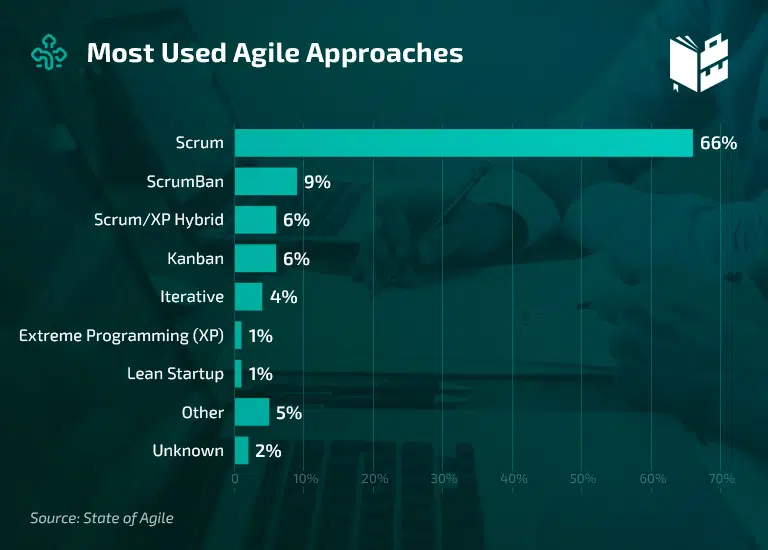The Agile methodology promises numerous benefits that companies love. One of the best advantages of using Agile is a relatively short time-to-market which saves both internal and external stakeholders precious time and money. Other benefits include heightened productivity, intuitive teamwork, increased efficiency, and more. The Agile mindset is particularly useful for organizations that are interested in scaling up.
Adopting the Agile framework means stepping away from certain traditional mindsets. A fixed mindset is an attitude or belief system in which an employee becomes an expert in their relevant field through a specific training plan and study.
They then believe that no one else can learn the skills that they know and also that they don’t need to diversify their own skill set. Agile differs from this mindset and follows its opposing belief system, i.e., the growth mindset.
A growth mindset is true to its name: it encourages growth and evolution and works to break skill barriers. An employee with a growth mindset believes that they can always learn new things and keep developing their role in the organization. They’re not afraid of failure and enjoy taking certain risks that will pay off in the long run, i.e., risks that will aid their growth.
Inspired by this, Agile encourages growth, communication, and peer-to-peer recognition, making it a sought-after framework for companies. In fact, KPMG reports that approximately91% of organizations say it is strategically vital to implement Agile.

Image Sourced from whattobecome.com
What is Agile methodology?
The Agile framework teaches members of an organization to work according to a growth mindset where they continuously improve their individual skills and develop the organization as a whole. The mindset encourages teams to work away from their silos and collaborate in ways that increase job satisfaction, productivity, mutual respect, and efficiency.
There are several methodologies used to monitor projects. Some examples are Scrum, Kanban, ScrumBan, Lean and others. Scrum is the most popular one out of these because it’s a light framework and guarantees excellent performance. This framework uses teamwork to foster productivity and motivation during a project’s lifetime.
Agile performance is at its peak when team members can work in self-motivated and disciplined groups, capable of resolving issues on their own without senior management having to step in. The key is teamwork; Agile focuses on larger collaboration and not the inter-departmental kind. For example, in an Agile mindset, UI/UX designers work closely with creatives, marketers, and more to develop the perfect product. No one works in a silo and this is how Agile brings employees together.
Let’s take a look at how you can foster an Agile mindset in your organization.

Free to use image sourced from Freepik
How to adopt the agile framework
Here are some ways that you can encourage your team to work with an Agile mindset:
1. Keep communication open
The Agile framework ensures that everyone gets a say in the development process, i.e., everyone gets to contribute productively. Make sure you stay open to ideas, and more importantly feedback, to give everyone a chance to speak up in your meeting, which you can conduct with any free video conferencing options available. In many instances, it’s harder to receive feedback than to give it, but you can teach yourself to be open to critique when required.
A clear and organized workflow helps keep communication running. You can appoint a Scrum Master who will build a definitive structure for your team until they can create one on their own. You can check workflow process guides for inspiration.
If you allow your team members to have a proper say in their work and encourage everyone in the organization to give and professionally receive feedback, the Agile mindset will be easy to implement. The Scrum Master can guide your team towards crystal clear communication until they can build trust and create their own flow of information.

Free to use image sourced from Freepik
2. Think of the customer experience
Encourage your team to continuously place the customer experience as their sole focus throughout any project journey. For example, a user’s three-way calling keeps dropping, so your focus here is to find and fix the issue. Agile is all about fixing bugs, so the consumer-end product is delivered in its most complete form. And after listing your continuous testing metrics, you can run automated and human testing to ensure that your product meets the necessary requirements before launch.
Foster the Agile framework with quick sprints where the team gets together and updates the Scrum Master on their achievements. They will receive valuable feedback that will redirect their focus to the consumer, saving you time and costs. The team will also feel like they’re working to achieve a shared goal, increasing motivation, job satisfaction, and productivity.
If you can’t implement sprints right away, you can start off with one-on-one meetings. It’s important for the Scrum Master to learn as many stand-up meeting tips as they can to make the relevant team member feel at ease. These meetings might come as a bit of a shock to certain employees who are used to working by themselves. But with time, they will adapt to the spirit of collaboration and open communication as the meetings progress and become regular.

Free to use image sourced from Pixabay
3. Get rid of absolutes
One of the ways in which Agile fosters a growth mindset among teams is by getting rid of absolutes. There is no central or agreed-upon way to execute a project, and everyone gets a say in how they want to work towards deadlines. The traditional method of implementing a top-down strategy can lead to alienation and poor job performance.
With an Agile mindset, however, you can lead your team to collaborate effectively with a gentle and open approach. This creates self-regulating teams that come to rely on each other for quick solutions in case of sudden problems or even develop forecasting techniques. They also become more flexible to last-minute changes and can step in when things don’t go according to plan.
Foster the Agile mindset by telling your team that there is nothing they can’t solve if they work together and that there is no right or wrong way to undertake tasks. There are external factors that they will have to learn to work around, and Agile will help them adapt to ever-changing consumer and market demands.
4. Focus on leadership
Traditional bureaucratic methodology has misrepresented what a leader should look like. A leadership attitude does not work with top-down communication, gives orders, and instills a patriarchal hierarchy at the office.
Rather, the Agile framework adds flexibility and responsiveness to a leader’s toolkit, ensuring that he or she steps beyond what is required of normal leaders so they can lead their team to extraordinary achievements.
The people managers in your team need to be trained in the agile methodology. It would do them good to be taught by professionals, but you could also encourage your team leads to read up on Agile-based leadership roles and gradually implement them. It’s important for leaders to establish a trusting relationship with their team so they can be aware of current progress and the status of the backlog.
They should use stand-ups to engage team members in various exercises that create genuine connections: think ice-breakers and jokes. While a plaine old telephone service (POTS) is still an option, a cloud collaboration service will work best for team members that are working from home to ensure they don’t feel left out.
Agile leaders know that they must guide their teams but never dictate them, direct them but never micromanage them, and be around in case the team needs support.

Free to use image sourced from Pixabay
5. Encourage skill sharing
Agile places great importance on cross-departmental collaboration because when different team members come together, they can teach each other useful skills. For example, a creative director can learn how to use design software, while a UI/UX designer can learn the basics of advertising. Your employees never have to stop advancing their skill sets if you adopt the Agile framework.
Implement Agile methodology by hosting skill-sharing workshops so your team members can transfer valuable skills, helping each other grow. They will act as neural network partners, transferring useful information that gets disseminated throughout the network. This also contributes to organizational growth as these employees will use new skills to expand the company.
Enjoy the journey
Keep in mind that the journey to Agile will encourage open communication, reliability, and flexibility in your team. It’s not something that can instantly be enforced, meaning you have to be patient and enjoy your way to adopting Agile completely. There might even be resistance from certain employees who prefer to stick to the traditional route of performing tasks.
Make sure you work closely with traditionalists as well as those with a growth mindset because Agile brings everyone together in the spirit of teamwork. You’ll be rewarded because once you foster an Agile framework in your organization, you’ll have a fully functional, self-regulating team that can adapt to any circumstance on its own.



